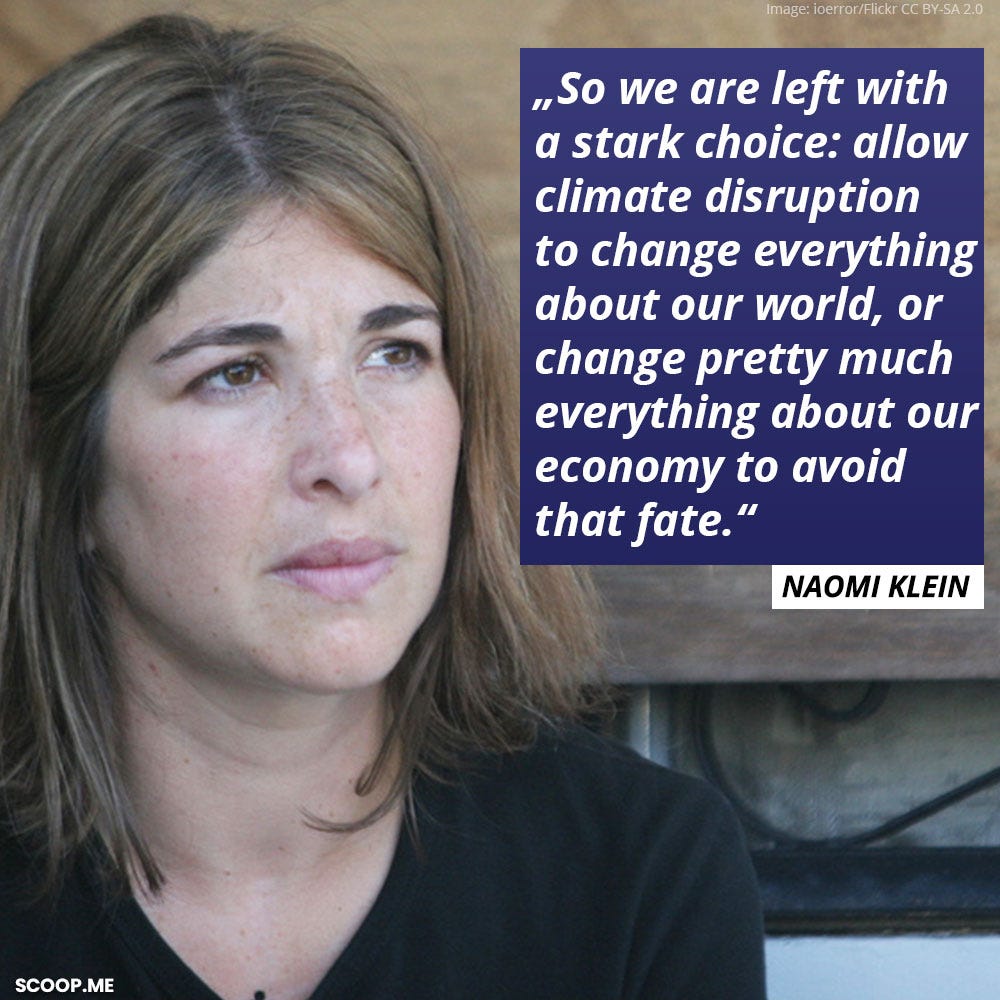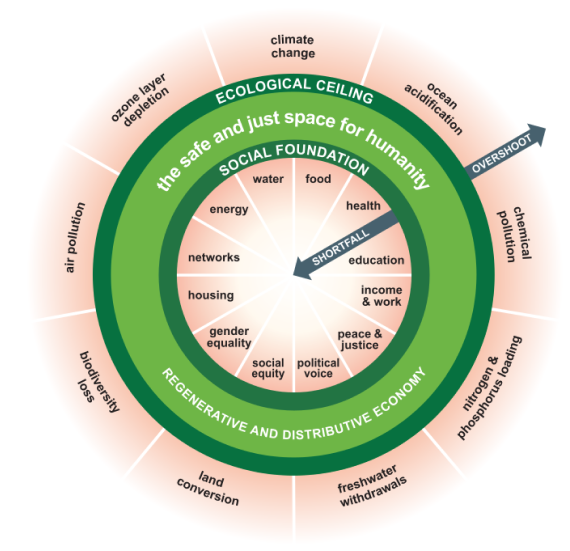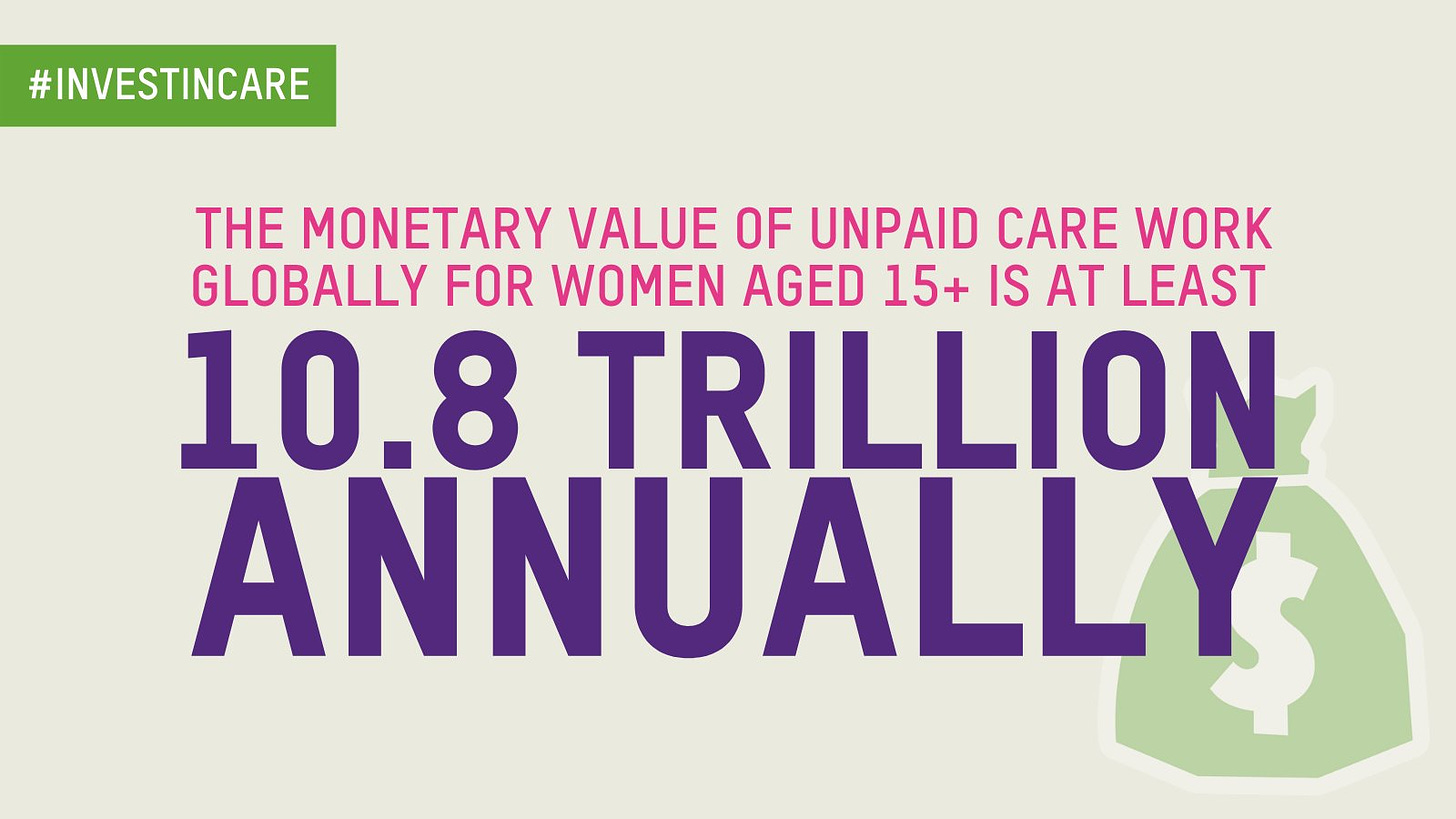What a doughnut can teach us about building a sustainable society
And why we talk about decolonisation in a climate newsletter.
Some of our readers have said that it’s not clear why we cover topics like decolonisation and feminism in a climate newsletter.
So for those who are starting to navigate the world of climate justice, I want to make it clear.
Every fight for Palestine, decolonisation and feminism is also a fight for the climate.
Imagine, hypothetically, if we arrived at a climate-friendly Europe without addressing any of the inequalities in our current society. We would arrive at yet another government run by white men in the Global North, where materials and labour for our solar panels and wind turbines were extracted from poorer countries in the Global South. Much like the green gentrification in some cities today, women, racialised groups, disabled people and low-income communities find themselves excluded and carrying the burden of the transition. Same story, different materials.
The flaw in this hypothetical is that we can’t arrive an ecologically stable world without addressing social injustice.
Why? Firstly, because the root causes of racial injustice, gender injustice and climate disasters are the same - so we cannot fix one without the others. We live in an economic and political system that makes it profitable to exploit others. Capitalism is born from the minds of men in the Global North, and incentivises a ‘race to the bottom’ to maintain exponential GDP growth. This drives corporations to raze forests and gut the land - no matter if it means leaving local communities homeless, capitalising on war, or dissolving trade unions in the process.
(This is usually the moment that some dudebro who wants me to know he’s got a degree in finance tells me that this is why we have to arrive at a ‘free market’ where sustainable solutions are more appealing to investors. But let’s be clear: a market where sustainability is an ‘option’ is not a sustainable economy, nor do we have to ‘balance’ profitability with ecology. We have to stop tweaking a machine that is corrupt by design).
Western countries have been able to accumulate so much wealth and power largely as a result of centuries of colonisation and enslavement. Even centuries later, we condemn our past of slavery - while we buy shirts made by underpaid women in Bangladesh and phones with copper mined by children in the Congo. The impacts of those centuries of inequality remain unaddressed.
Meanwhile, while rich men in rich countries now have enough money to finance climate mitigation five times over and lift 2 billion people out of poverty, the same groups who have been exploited remain without resources or power to adapt to climate degradation.
Capitalism incentivises colonisation, injustice and climate destruction.
Not only are injustice and climate destruction two faces of the same problem - the solution is the same. It is well-documented that the leadership of women, racialised groups, disabled and Indigenous groups lead to more democratic, accessible and inclusive climate solutions. And that alternative economies to capitalism exist and can work to improve quality of life, human health and ecological wellbeing.
But none of that will happen when women are barred from voting, indigenous people are left homeless and black people are arrested and shot for existing on the street.
Any effective climate solution will also have collective human liberation at its core. We are an ecosystem - there is no part that can be left unprotected.
What’s Going On?
The EU is bending rules to allow trade with Israeli settlements.
Related: Netflix wipes its series of Palestinian stories - people call for their return.Signs of ecological recovery show potential for mass rewilding in Ukraine.
Related: Mapped: How Big Ag, Pharma, Pesticides and other industries hope to sway the UN Biodiversity talks.US cities seek to ‘Trump-proof’ policy against inequality ahead of election.
Related: A group of 30 US oil lobbyists have created a plan for how to dismantle climate policy if Trump wins.Climate conference host Azerbaijan set for major fossil gas expansion.
Related: Curbing the emissions of the 1% is crucial to tackle climate breakdown, poverty and hunger.UNEP calls out the ‘massive gap between rhetoric and reality’ in country climate goals.
Related: G20 countries water down climate finance report by top economists anyway.
If you’d like to support The Green Fix, please consider tipping us a virtual coffee.
Focus On… Doughnut Economics
In a recent interview, Vinz Kanté from LIMIT spoke with Kate Raworth during her visit to Brussels. Edited by Alexandra Vazquez Mera.
Kate Raworth is an ecological economist, creator of the ‘Doughnut’ model of social and planetary boundaries. She is also the co-founder of Doughnut Economics Action Lab, which is putting the Doughnut ideas into action with communities, cities, businesses, and educators.
What is the Doughnut?
The Doughnut is a visual framework for a 21st-century compass for humanity. Think of it as a guide for how to ensure everyone has what they need to thrive while staying within the limits of our planet.
Picture a doughnut with two rings. The inner one is the social foundation. It represents the minimum social standards everyone should have access to, like healthcare, education, food, water, housing, and political voice.
The outer ring represents the ecological ceiling. It’s the planetary boundaries we must not overshoot to avoid ecological breakdown, including climate change, ocean acidification, and biodiversity loss. The space between these two rings, the donut itself, represents the "safe and just space for humanity".
You've been critical of traditional economics. What are its biggest shortcomings, and how does the Doughnut offer a more relevant framework?
The economics I was taught in university was obsessed with endless economic growth. It's like that old diagram of an arrow pointing ever upward, going right through the ceiling! But nothing in nature grows like that forever. Traditional economics largely ignores the living world. It rarely acknowledges that the economy is embedded in the environment and completely dependent on it for resources.
This outdated model also fails to account for power dynamics, historical injustices, and social inequalities. For example, the unpaid care work predominantly done by women, which underpins our societies, is largely invisible in economic models. And the history of colonialism, which enabled resource extraction from the Global South to fuel the wealth of the Global North, is often overlooked in economic narratives.
Why are we still stuck in the old economic model?
Current economic models that focus on endless growth are outdated and destructive, failing to account for the planet's finite resources and social equity. This model was created by white men in the Global North who ignored the limitations of resources and the contributions of women and colonised peoples.
It focuses on financial realities rather than ecological breakdown, social crises, and unpaid care work. It prioritises profits for the wealthy while ignoring the degradation of the living world and the needs of many.
Politicians often cling to these outdated models due to their familiarity and perceived simplicity. The concept of endless growth provides a comforting narrative that is easily understood and communicated to voters. Deviating from this well-trodden path requires explaining and defending alternative approaches, which many politicians find challenging or politically risky.
What needs to change?
Imagine a hosepipe, where we take resources from the Earth at one end, make them into products, use them briefly, and then spew out waste at the other end. That’s the linear economy that's pushing us beyond our planet's limits.
We need to transform that linear system into a circular one, where resources are used more carefully, creatively, and collectively. It's about designing products to last, reusing and repairing them, and ultimately creating closed-loop systems where waste from one process becomes food for another. It’s about moving from a degenerative economy to a regenerative one.
Instead of relying solely on market forces, which often lead to unequal access, we also need to prioritise public provisioning of essential services like healthcare, education, and transportation, ensuring that everyone can meet their basic needs.
Protecting and regenerating nature is crucial, shifting from a mindset of extraction to one of stewardship. Investing in natural capital, internalising environmental costs, and adopting regenerative practices are key.
This also involves questioning the dominance of globalised trade, which often comes at the expense of social and ecological well-being in the Global South. A more localised approach, promoting regional self-sufficiency and South-South trade, is essential for achieving a just and sustainable future.
Which countries are leading the way?
Costa Rica is the country currently closest to achieving the model's goals. They've made impressive strides in social well-being, with high levels of healthcare and education, and all of this on an income that’s less than a third of many high-income nations! They've also demonstrated leadership in forest conservation, showing that protecting nature can go hand-in-hand with economic benefits.
This highlights that you don't have to be the wealthiest country to provide a good life for your citizens and respect planetary boundaries. Investing in public goods like healthcare, education, and environmental protection is essential.
How can we inspire people to make this transition?
We have to create new narratives that celebrate the joy of connection, creativity, and collaboration. We need to demonstrate that a good life doesn't have to be built on an endless accumulation of stuff.
Think about the excitement people feel when they discover a building or a café that has been creatively repurposed from an old factory or train station. That sense of history and reinvention is something we need to tap into. Reusing materials, repairing things, and sharing resources can be deeply satisfying and fun. We need to make those ways of living not just sustainable, but also truly desirable.
You’ve been working with policymakers, cities, and communities around the world to implement the Doughnut. What are some of the most common challenges you encounter, and what gives you hope?
One challenge is overcoming the inertia of "business as usual". It’s easy for politicians and businesses to stay stuck in the old growth-focused mindset, especially when there's pressure to please voters or shareholders in the short term. But the Doughnut is hard to argue with. Who would want to defend poverty or ecological destruction?
What gives me immense hope is the growing groundswell of people, from mayors to community activists, who are stepping up to lead the way. They're demonstrating that the Doughnut is not just a theoretical model but a practical tool for transforming our cities, businesses, and economies. We're seeing inspiring examples of Doughnut-inspired policies and projects emerging around the world, proving that real change is possible.
You can follow the Doughnut Economics Lab on their website and on X @DoughnutEcon, Instagram @doughnuteconomics and LinkedIn.
So Now What Do I Do?
LEARN SOMETHING
Read: What’s the difference between doughnut economics and degrowth?
Read: What does it mean to live well within planetary limits? [Our interview with Dr Julia Steinberger a few months ago!]
TRY SOMETHING NEW
Ghost a lobbyist this Halloween at the Fossil Free Politics afterwork on 31 October in Brussels.
Apply to be a Social Media Ambassador for the Global Landscapes Forum! Deadline 30 November.
CHANGE THE SYSTEM
The deadline for the Fossil Free Finance Advocacy Lab closes tomorrow! Activists from NGos or grassroots movements eligible to apply.
Tune into this hybrid conference on new economies for a shifting landscape on the 7 November.
Preparing for whoever wins in the US elections - a primer by BadSchoolBadSchool.
The Green Fix is now offering low-cost sponsored slots on the newsletter. Book your slot by emailing wearethegreenfix@gmail.com.
Stay in the loop
You can follow us on Twitter @TheGreenFix, Instagram @thegreenfix_ and LinkedIn. Connect with Cass on Instagram @cass.hebron and LinkedIn Cass J Hebron.









